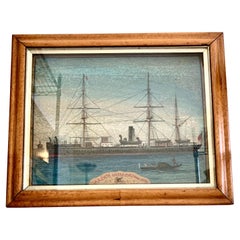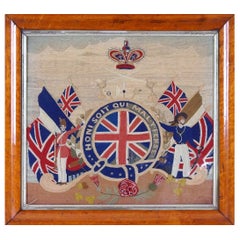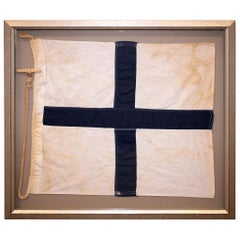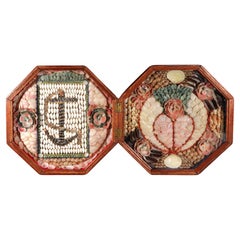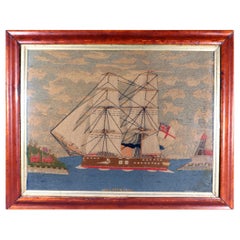Late 19th Century Nautical Objects
11
to
11
11
11
11
10
1
31
5
2
2
1
8
8
2
1
1
10
8
8
1
1
Period: Late 19th Century
Recognized Seller Listings
19thC Nautical Six Spoke Solid Brass Yacht Steering Wheel. American, Circa 1870
Located in Incline Village, NV
This 19th century American solid brass ship steering wheel was, more than likely, from a yacht. Fishing and commercial boats were more inclin...
Category
American Folk Art Antique Late 19th Century Nautical Objects
Materials
Brass
British Sailor's Woolwork of Royal Navy Ship
Located in Downingtown, PA
British Sailor's Woolwork of Royal Navy Ship,
The sailor's woolwork or woolie depicts a starboard view of a Second-Rate Royal Navy Ship with three masts. T...
Category
English Folk Art Antique Late 19th Century Nautical Objects
Materials
Wool
Large Italian Painting of a Merchant Ship "The Venetian Workers' Society Offers"
Located in Katonah, NY
A unique work of art, this charming painting was hand painted in Italy in the mid-19th century.
Created to promote The Venetian Workers' Society, this large hand-painted oil paintin...
Category
Italian Folk Art Antique Late 19th Century Nautical Objects
Materials
Glass, Wood
British Sailor's Woolwork, With Motto of The Order of The Garter
Located in Downingtown, PA
British Sailor's Woolwork,
With Motto of The Order of The Garter,
Circa 1880.
The unusual sailor's woolwork depicts a soldier and a sailor standing and pointing with one hand to either side of a circular device in the form of a garter with the Union Jack within and the motto "Honi soit qui mal y pense...
Category
English Folk Art Antique Late 19th Century Nautical Objects
Materials
Wool
British Sailor's Woolwork of Three Royal Navy Ships, Circa 1885
Located in Downingtown, PA
British sailor's woolwork of three royal navy ships
Circa 1885
The British sailor woolwork depicts an unusual scene of three different types of Royal Navy Ships which are all flying the White...
Category
English Folk Art Antique Late 19th Century Nautical Objects
Materials
Wool
Sailor's Woolwork of Royal Navy Five-Masted Ship under Steam, Minotaur Class
Located in Downingtown, PA
Sailor's Woolwork of Royal Navy Five-masted Ship under Steam,
HMS Minotaur or HMS Agincourt,
Minotaur Class Broadside Ironclad,
circa 1880
The sailor's woolie depicts a portsi...
Category
English Folk Art Antique Late 19th Century Nautical Objects
Materials
Wool
British Sailor's Woolwork or Woolie of the Named Barque "Polly"
Located in Downingtown, PA
Large British Sailor's Woolwork of the Barque Polly,
Named "Polly",
Circa 1885-95
A large sailor's woolie or woolwork of a port side view of a ship named "Polly" under full sail. The ship is rigged as a barque.
The name "Polly" can be seen on a banner flying from the mainmast and on the front of the bow and the shiop was named after the owner's wife Marian Poyy Woodside. (see below). The sails are trapunto, creating a three-dimensional look of the sails full of wind. The sea is depicted is rippling bands of green and white.
Dimensions: Frame: 26 1/4 inches high x 31 inches wide x 2 inches
Reference: The ship was built in Belfast, Northern Ireland, in 1885, and launched by Marian "Polly" Woodside, the wife of the owner, tossing flowers across the bow. (Champagne being too precious). The ship made several voyages primarily between South America and the UK before being repositioned in the Pacific.
A barque has three or four masts. The fore and mainmast are square-rigged, and the mizzen fore-and-aft, usually gaff-rigged. Carries a mainsail on each mast, but the mainsail shape differs per mast (square or gaff). Barques were built with up to five masts. Four-masted barques were quite common.
Barques were a good alternative to full-rigged ships because they require a lot fewer sailors. But they were also slower. Very popular rig for ocean crossings, so a great rig for merchants who travel long distances and don't want 30 - 50 sailors to run their ship.
A label on the reverse states that the wool was on The Antiques Road...
Category
English Folk Art Antique Late 19th Century Nautical Objects
Materials
Wool
Intricate Blown Glass Ship, Late 19th Century
Located in York County, PA
Exceptional and intricate blown glass ship, in red, white, and blue, tall and shapely with a billowing commission pennant and flag, probably Czechoslovakia, last quarter of the 19th century
This mindboggling, intricate little ship is one of the more remarkable pieces of blown glass that I have ever encountered. Probably Czech-made and similar in nature to some of their most rare and extraordinary, figural, blown glass Christmas...
Category
European Antique Late 19th Century Nautical Objects
Materials
Blown Glass
British Woolwork 'Woolie' of Three Ships
Located in Downingtown, PA
Large British woolwork of three ships including the Ada and two smaller craft,
circa 1875.
The wool depicts three ships- a port side view of The Merchant ship Ada, another sail-i...
Category
English Folk Art Antique Late 19th Century Nautical Objects
Materials
Wool
Gwen, a Named British Sailor's Woolwork
Located in Downingtown, PA
British Sailor's Woolwork or Woolie,
The Gwen,
Circa 1875
The small British sailor's woolie depicts a starboard view of the brigantine Gwen sailing on a calm blue sea and flying...
Category
English Folk Art Antique Late 19th Century Nautical Objects
Materials
Wool
Sailor's Woolwork Woolie of Gaff-Rigged Sloop with Two Other Ships
Located in Downingtown, PA
Sailor's Woolwork Woolie of Gaff-rigged Sloop,
Circa 1870
The British sailor's woolwork or woolie depicts a starboard side view of a gaff-rigged sloop under full sail against a clou...
Category
English Folk Art Antique Late 19th Century Nautical Objects
Materials
Wool
Related Items
Framed ICS Letter Signal Pennant "X"
Located in Norwell, MA
International Code Signal letter pennant. Stitched white linen panel with navy blue, centered cross representing the letter X for Xray meaning "Stop carrying out your intentions and ...
Category
Late 19th Century Nautical Objects
Materials
Cotton
British Soldier's Woolwork or Woolie, 19h Century
Located in Pasadena, CA
This is an exceptional example of a 19th century British soldier's "Woolie" or woolwork that is signed "G.W. Whitby/India. The woolwork depicts the ...
Category
English British Colonial Antique Late 19th Century Nautical Objects
Materials
Wool, Glass, Wood
Sailing Ship Diorama 19th Century Signed
Located in Norwood, NJ
George Vempley Burwood British (1844-1917) signed and dated. Sailing ship, schooner diorama shadow box with figures and painted background.
Category
British Victorian Antique Late 19th Century Nautical Objects
Materials
Glass, Wood, Paint
The Painting "Ship in the port"
Located in Chorzów, PL
Dimensions:
Frame: height 43.5 cm / width 49.5 cm
Painting: height 30 cm / width 35 cm.
Category
Danish Other Vintage Late 19th Century Nautical Objects
Materials
Canvas
Victorian Sailor's Woolwork Picture of Ships and Rowing Boats
Located in Chelmsford, Essex
Antique Sailor's Woolwork Embroidery Picture of two sailing ships and sailors in rowing boats. One of the ships is steam powered, with smoke coming out of the chimney/smokestack. Dra...
Category
English Antique Late 19th Century Nautical Objects
Materials
Wool
Victorian English Nautical Diorama Ship Wall Plaque
Located in New York, NY
English Country style Victorian diorama in oak case of sail/steam ship with small lighthouse.
Category
Victorian Antique Late 19th Century Nautical Objects
Materials
Oak
British Sailor's Large Woolwork Woolie of a Sailing Ship
Located in Katonah, NY
This large 19th century sailor's Woolie of a British line-of-battle ship, circa 1840is
is hand embroidered with woolen yarn. It depicts a British naval ship under full sail with can...
Category
English Folk Art Antique Late 19th Century Nautical Objects
Materials
Wool
19th Century Sailor's Decorated Sea Chest, signed.
Located in Nantucket, MA
Antique Sailor's Sea Chest, Late 19th Century, a British sailor's sea chest made from tropic hardwood, possibly teak, of heavy, solid brass-bound construction with dove-tailed joints...
Category
English Folk Art Antique Late 19th Century Nautical Objects
Materials
Hardwood
British Sailor's Large Woolwork of HMS Brunswick
Located in Downingtown, PA
British Sailor's large woolwork of HMS Brunswick,
Circa 1865
The large sailor's woolwork depicts an image of a Royal Navy Second Rate Battleship. By repute she is the HMS Brunswick ...
Category
English Folk Art Antique Late 19th Century Nautical Objects
Materials
Wool
19th Century Painting of Island Lighthouse in Maine, Signed E. Chase
Located in Nantucket, MA
19th Century Painting of Island Lighthouse in Maine, signed E. Chase, an oil on board folk art painting of what appears to be Nash Island Light in Maine with square light tower...
Category
American Folk Art Antique Late 19th Century Nautical Objects
Materials
Other
Late 19th Century Sailor's Knot Board
Located in Nantucket, MA
Antique Sailor's Folk Art Knot Board, circa 1880s, an intricate and elaborate array of approximately 41 bends, hitches, knots, splices, rigging and other fa...
Category
American Folk Art Antique Late 19th Century Nautical Objects
Materials
Rope, Oak
Folk Art Ship Model
Located in Doylestown, PA
A naive Folk Art ship model in carved wood with fabric sails and elaborate rigging, American, circa 1900.
Category
American Folk Art Late 19th Century Nautical Objects
Materials
Wood
Previously Available Items
Double Sailor's Valentine with Large Anchor, Barbados Barbados, West Indies
Located in Downingtown, PA
Double Sailor's Valentine with Large Anchor, Barbados
Barbados, West Indies,
Circa 1885
The double sailor's valentine from Barbados is formed within two hinged octagonal mahogany cases with the original loop clasp to the side. On the right side is a central oval design with the charming motto, "Forget Me Not" and on the left side a central heart shape all formed by different shells.
Dimensions:
18 1/4 inches wide x 9 1/8 inches high x 2 3/4 inches deep (closed)
Each side 9 1/8 inches x 9 1/8 inches x 1 1/4 inches deep open
Reference:
Sailors’ Valentines originated in the mid-1800s. The majority of Sailors’ Valentines came from the West Indies Island of Barbados, a Port of Call for American and English ships1. Sailors would buy or trade items for these nautical tokens as romantic gifts to take home to their loved ones during their long voyages at sea. Although Sailors’ valentines were made as early as the 1750s, they did not become popular until 1830s. The sailors’ valentine craze lasted until 1890, albeit some examples were made into the early 20th century.
Sailors’ valentines are a form of shell craft, a type of mostly antique souvenir or sentimental gift made using large numbers of small seashells. These were originally made between 1830 and 1890, and they were designed to be brought home from a sailor’s voyage at sea and given to the sailor’s loved...
Category
Bajan Folk Art Antique Late 19th Century Nautical Objects
Materials
Shell
H 9.13 in W 18.25 in D 1.25 in
British Sailor's Woolwork Picture of HMS Temeraire
Located in Downingtown, PA
British sailor's woolwork picture of HMS Temeraire,
Circa 1880
The sailor's woolwork depicts the port side view of the Royal Navy ship H.M.S. Temeraire as she sails out to seas past a lighthouse on her starboard side and two red-bricked houses on a point on the Port side on a calm blue sea and below a cloudy sky.
The wool is done in a chain stitch and now with Museum UV glass.
When Gerard Noel took command on 26 October 1889, Termeraire was the last ship to carry sails on its masts.
Dimensions: 23 inches high x 28 3/4 inches wide
Armament
Her armament was partly conventional, being deployed on the broadside, and partly experimental; she was the first British ship to be equipped with guns in barbettes located on the midline on the upper deck. Indeed, she was the first British ship with barbettes of any kind. The armament consisted of four 11 inch muzzle-loading guns, one each on the forecastle and stern, and one each at the forward corners of the central battery to port and starboard. The 11 inch guns were installed on a Moncrieff mount, which had a mechanism for raising and lowering the gun. The mount was on a massive turntable that provided enough space for the hydraulic ramrod. The loading and lifting process, as well as the rotation of the mount, were operated by a disguised stand with four control levers. When the gun was extended and aimed at the target, it was adjusted to elevation graduated in degrees by a rod linkage on each side of the breech. A full gun crew consisted of six men, but the guns could be operated by three in an emergency. In addition, four 10in muzzle-loading guns were located in the rear of the central battery, two on each broadside. To protect against attack by boats armed with torpedoes, the ship received four 20-pounder breech-loading guns. Temeraire was also fitted with two launchers for spar torpedoes. In 1884, the 20-pounders were replaced by four 25-pounder breech-loading guns, and four 3-pounder Hotchkiss and ten 3-pounder Nordenfelt QF guns were also added to the ship.
Armour
The armored belt extended along the entire length of the ship. It was 11in thick amidships and had a total height of 18.8in, of which 10in was above and 8.9in below the waterline. Towards the bow and stern it tapered to 5in and 5.5in respectively. The central battery was protected by 8in sides and 5in transverse bulkheads. The oval barbettes were protected by 10in forward and 8in aft. This shape was necessary to make room not only for the guns to be lowered, but also for a hydraulic ramrod, which was opposite the gun muzzle and almost as long as the barrel itself. The wider end was open at the top to allow the gun to rise and fire, and the narrower end with the ramrod was covered with iron plates. Its distinctive feature was a complete and continuous armor by a parapet that rose 36in above the deck surrounding it, protecting the gun crew and the gun itself when loaded or not in use.
Service history
The Temeraire named after the French ship of the line Téméraire captured in 1759, was laid down at Chatham on 18 August 1873, launched on 9 May, and commissioned in 1877 for service in the Mediterranean fleet under Captain Michael Culme-Seymour. She remained there for the next 14 years except for the winter of 1887-88 when she was part of the Channel Squadron. Upon her arrival in Besika Bay, she became Admiral Hornby's flagship. In 1878 she was ordered to the Dardanelles to observe the progress of the Russo-Turkish War. She remained near Istanbul (then Constantinople) until 1879 to represent a strong British position during the protracted international negotiations that led to the Congress of Berlin.
She then took part in the reconquest of Ottoman-occupied Cyprus. In 1881 she was paid off in Malta and given a new command. At the outbreak of the Anglo-Egyptian War in 1882, she was recommissioned and took part in the attack on the defensive positions on the coast of Alexandria. In 1884, she was again decommissioned and recommissioned the same year for service in the Mediterranean under Compton Edward Domvile. In 1887 she returned home and was paid off at Porthsmouth.
After being recommissioned for service in the Channel Squadron, she visited Vigo, Genoa, and Lisbon. She then returned home, but the growing threat from the French fleet at Toulon made it necessary to increase British forces in the Mediterranean as well. Therefore, Temeraire was reassigned to the Mediterranean Fleet under the command of James...
Category
Folk Art Antique Late 19th Century Nautical Objects
Materials
Wool
Gwen, a Named British Sailor's Woolwork
Located in Downingtown, PA
British Sailor's Woolwork or Woolie,
The Gwen,
Circa 1875
The small British sailor's woolie depicts a starboard view of the brigantine Gwen sailing on a calm blue sea and flying...
Category
English Folk Art Antique Late 19th Century Nautical Objects
Materials
Wool
Antique Folk Art Red Cat Shell Valentine
Located in Downingtown, PA
Antique red cat sailor's Valentine,
Probably American,
Circa 1880-1920
The remarkable sailor's valentine is of square form with a dense pattern of sea she...
Category
Folk Art Antique Late 19th Century Nautical Objects
Materials
Shell
Sailor's Woolwork Woolie of Gaff-Rigged Sloop with Two Other Ships
Located in Downingtown, PA
Sailor's Woolwork Woolie of Gaff-rigged Sloop,
Circa 1870
The British sailor's woolwork or woolie depicts a starboard side view of a gaff-rigged sloop under full sail against a clou...
Category
English Folk Art Antique Late 19th Century Nautical Objects
Materials
Wool
Free Shipping
H 21.25 in W 27 in D 1.75 in
Sailor's Woolwork of Large Proportions with Multiple Ships
Located in Downingtown, PA
Sailor's Woolwork of Large Proportions with Multiple Ships,
Circa 1865
The extremely large detailed woolwork depicts, in the center, a fully dressed First Rate Royal Navy Battlesh...
Category
English Folk Art Antique Late 19th Century Nautical Objects
Materials
Wool
Sailor's Valentine, Barbados, West Indies
Located in Downingtown, PA
West Indian Sailor's Valentine,
Circa 1880
The large single sailor's valentine is composed of a variety of shells in concentric and geometric patterns, centered with a pink peony enclosed within a pointed star within an octagonal stained wood frame.
Dimensions: 13.86 inches wide x 13.82 inches (35.2cm wide, 35.1cm high)
The sailor's valentine
A sailor's valentine is made of one, or, more often, a hinged pair of octagonal wooden display cases lined with fabric. Small shells, seeds, or other materials are glued to the fabric, usually forming a colorful design. The name "sailor's valentine" comes from the fact that there is usually a sentimental phrase, such as "Forget Me Not," "With Love," or other sayings that we use on Valentine's Day. The shape is thought to come from old compass cases carried aboard sailing ships.
Seashell collecting became popular by the early 1800s, especially in England and America. By the mid-1800s, sea shells were brought back from the Caribbean to Europe and America for use in home display cases. This interest in shell collecting may have later inspired the idea of the sailor's valentine, and the intricate shell display cases influenced the busy designs of these affordable souvenirs of sea voyages.
Research has discounted the long-held belief that these were made by sailors themselves as a shipboard diversion. Several facts point to the West Indies...
Category
Antique Late 19th Century Nautical Objects
Materials
Shell, Wood
British Sailor's Woolwork (Woolie) of British Soldier and a Sailor with Flags
Located in Downingtown, PA
British Sailor's Patriotic Woolwork with a British Soldier and a Royal Navy Sailor with Union Jack and White Ensign,
Circa 1880
The sailor's woolwork of ...
Category
English Folk Art Antique Late 19th Century Nautical Objects
Materials
Wool
H 26.5 in W 25.75 in D 2 in
British Sailor's Woolwork, the Sailor's Farewell
Located in Downingtown, PA
British sailor's woolwork of The Sailor's Farewell,
Circa 1865.
This is a particularly lovely example of this rare sailor's woolie subject. The Sailor’s Farewell and the Sailor's...
Category
English Folk Art Antique Late 19th Century Nautical Objects
Materials
Wool
Sailor's Woolwork of a Fleet of Nine Royal Navy Ships, 1875
Located in Downingtown, PA
Sailor's woolwork of a fleet of nine royal navy ships,
1875
A wonderful and dramatic sailor's woolie of a starboard view of a fleet of nine Royal Navy ships of a variety of diffe...
Category
English Folk Art Antique Late 19th Century Nautical Objects
Materials
Wool
Sailor's Woolwork Woolie of Two Ships and Fort
Located in Downingtown, PA
Sailor's Woolwork Woolie,
First-Rate Royal Navy Ship,
Circa 1875
The sailor's woolie depicts the starboard view of a First Rate three-masted British Royal Navy Vessel flying the...
Category
English Folk Art Antique Late 19th Century Nautical Objects
Materials
Wool
Naive Folky British Sailor's Woolwork Ship Woolie
Located in Downingtown, PA
Great Color & Style!
Naive Sailor's Woolwork woolie,
circa 1875
The sailor's woolie depicts a portside view of a three-masted British Royal Navy Vessel under sail upon a varie...
Category
English Folk Art Antique Late 19th Century Nautical Objects
Materials
Wool
Recently Viewed
View AllMore Ways To Browse
Antique Flensing Knife
Hooked Rug Whaling
Wooden Bluenose Boat Model
Donald Macintyre
Large 18 Th Century French Country
Enamel Opera Glasse
German Furniture 17th 18 Th Century
Telford Grier Mackay
Seller 1161
Mid Century Vintage Kitchen Units
Antique French Room Divider
Chinese Vintage Style Cabinet
Cast Iron Cabinet
Desk With Return
Vintage Cabinet With Hutch
Painted French Display Cabinet
Vintage Wooden Chest With Drawers
Glass Display Case Drawer


